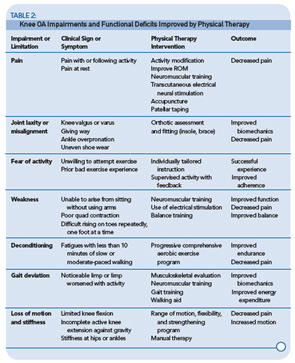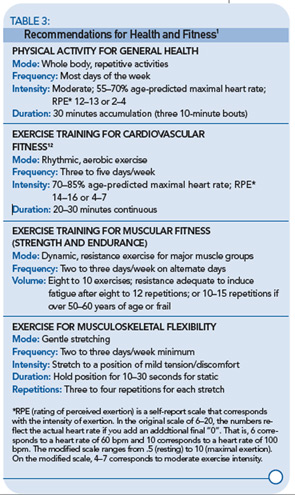Ask every patient at every visit: What are you doing for exercise now?
Your response depends upon the patient’s answer:
- If the activity lies within the exercise guidelines for fitness or the physical activity guidelines for general health (see Table 3) reinforce and encourage the activity.
- If your patient answers that he or she is not doing anything but would like to do something, or if what the patient is doing is inadequate, refer him or her to a community-based exercise or self-management program or suggest a home program. (Click here to download a sample home exercise program.)
- If your patient answers that he or she cannot exercise because of pain, is afraid to try, or exhibits the signs or symptoms listed in Table 2, consider referral to a physical therapist to help him or her overcome barriers and learn how to exercise successfully. Also, suggest a community arthritis-specific exercise program or self-management program for continued use and support.
Table 4 outlines the role of the healthcare professional in promoting exercise and the characteristics of a successful exercise program.

Exercise Starts at Home
Many people with mild to moderate knee OA can lessen pain and improve function and endurance with a simple home exercise program. Studies reporting successful home exercise interventions usually include initial instruction and supervision. The Enabling Self-management and Coping with Arthritic Knee Pain through Exercise (ESCAPE) trial also includes self-management training in the initial six-week period.6
Offering specific suggestions of safe and effective activities may help some patients get started. Basic strengthening and flexibility exercises, combined with a progressive program of regular walking or bicycling are a simple, no-cost routine that can be accomplished at home. (Click here to download a sample home exercise program.) Combining a beginning home program with referral to a self-management course helps the person learn skills, experience success, and develop self-efficacy for exercise, thereby improving adherence and outcomes.
Evidence-based Community Resources
Learning the self-management skills for self-directed exercise is central to long-term exercise maintenance.7 There are a number of community-based opportunities that offer initial instruction, access to a knowledgeable leader, and social support to gain these skills. The Arthritis Foundation and CDC-supported state Arthritis Programs are excellent sources of evidence-based programs. These programs have been shown to improve symptoms, reduce disability, and promote self-efficacy for managing the disease. The self-management programs include exercise information and teach skills that foster self-directed behaviors and success. Learn what is going on in your area, keep course information available in your office, and refer patients to these programs as standard care. The evidence-based programs recommended and supported by the Centers for Disease Control and Prevention (CDC) Arthritis Program are Arthritis Foundation Exercise Programs—Land and Water; Arthritis Self- Management Program; Chronic Disease Self-Management Program; and Enhance Fitness. More information about these exercise and self-management programs may be found at the following sites:
- Arthritis Foundation Chapter programs: www.arthritis.org/programs.php;
- CDC State Arthritis Program: www.cdc.gov/arthritis/state_programs/programs/index.htm;
- Enhance Fitness, a senior exercise program developed by the University of Washington: www.projectenhance.org; and
- A list of self-management programs, including chronic disease, offerings in Spanish, and international locations: http://patienteducation.stanford.edu.
Local hospitals, recreation centers, and fitness facilities offer exercise programs suitable for people with arthritis. Water aerobics, low-impact aerobic dance, cycling, strengthening, and tai chi are safe and helpful. Your own patients are a good source of information on what works, what doesn’t, and where to find good instructors and classes. Encourage patients to share experiences with you and your staff. It can be efficient to designate a specific staff member to be the knowledgeable exercise resource and talk with patients and families regularly.


